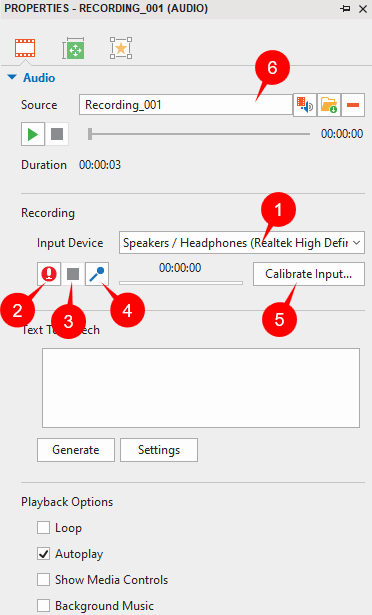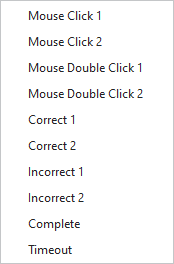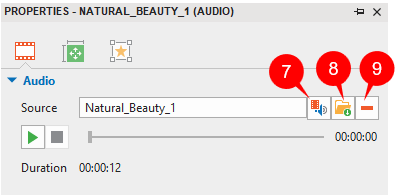As you may know, Audio and images are considered as a perfect pair in designing eLearning courses because of their ability to make lessons even more engaging, emotional, and memorable for learners. With the release of the new version, you now have many options to insert audio in ActivePresenter 8. Basically, the app allows you to add almost any sound to your projects with many formats, including MP3, OGG, WMA, and WAV.
Overall, there are four main ways to insert audio. Firstly, import audio from existing files. Secondly, record a new audio track right inside the app. Next, add built-in audio. Finally, use text to speech. In the same project, you can use these techniques to:
- Add an audio track into a single slide.
- Add an audio track as background music that plays during the entire project.
- Insert an audio track into a specific object such as shape, text caption and button.
After inserting audio in ActivePresenter 8, you’re free to edit the audio or remove it if you no longer need it in your project.
So, this article will explain how to perform these tasks. Now, let’s get started!
Insert Audio from Existing Files
In fact, the quickest way to insert audio from an existing file is to drag and drop it from your computer into the selected slide. Alternatively, check out the steps below:
Step 1: Select a slide.
Step 2: Access the Insert tab > Audio > From File… (1).

Step 3: Select audio from your computer, and click Open.
Then, you see an audio icon appears on the Canvas and the Time Bar of that audio in the Timeline pane.
Record an Audio
Instead of adding an existing audio file, ActivePresenter 8 lets you record your own one with two options. In case you have a microphone connected to your computer, you can record your own voice in real-time to be included on a slide. So, you can use:
- The Audio section in the Properties pane.
- The Record Narration button in the Timeline pane. This way comes in handy when you wish to match the voice with content in the project. Refer to Record Narration to get more details .
In the next part, we’ll show you step to step to insert audio by using the Audio section. Let’s perform this procedure:
Step 1: In the Insert tab > Audio > Create New (2).

Step 2: Navigate to the Properties pane > Media tab > Audio section. In order to record new audio, you need to work with all the features in the Recording part.

Bear in mind that:
- Input Device (1): Select a device from the drop-down list.
- Record (2): Start recording.
- Stop Recording (3): Select this when you’re done with the recording.
- Change Input Volume (4): Adjust the recording volume.
- Calibrate Input… (5): Set the audio recording devices to the appropriate level before recording. For full information about using this feature, take a look at Calibrate Audio Input.
Once you’re done with recording audio, your recording will appear in the Source box (6).
When a slide contains both narration and system audio (or audio track), the Timeline displays two different waveform bars as you can see in the picture below.

Note:
- If you want to capture an audio from the beginning when creating a new project, please check out the Record Audio from Microphone and System Audio tutorial to get detailed information.
- ActivePresenter doesn’t allow you to attach an audio to the following objects: cursor path, zoom-n-pan, closed caption, check box, and radio button. Besides, you can’t attach an audio to an object group.
- If the object duration is shorter than the recorded audio duration, the app displays a dialog to ask whether you want to extend the object duration to fit the duration of the generated audio or not. In case you don’t want to get this notification in the future, select Always do this for the next time check box.

- The Audio section also provides Playback Options to control how the audio is played. This is useful when you insert an audio as background music.
Insert Built-in Audio
When it comes to built-in audio, ActivePresenter 8 provides you with some useful interactive objects like mouse clicks and feedback messages. To insert built-in audio, do as bellow guiding:
Step 1: Select the object that you want to insert audio.
Step 2: Open the Insert tab > Audio > Built-in (3) and choose one in the audio drop-down list.

After that, you will see an audio icon on the Canvas and the audio Time Bar in the Timeline pane.
Insert Audio Using Text to Speech
Besides the three above techniques, ActivePresenter also offers you a facility to generate audio from text. This feature is practical in some cases, especially when the object has text and you want it to be “read out loud”. Check out the tutorial Use Text to Speech Feature to know more.
Customize an Audio
Replace an Audio

If you want to change the inserted audio, first select the audio icon on the slide. Then, navigate to the Audio section of the Properties pane. Now, you can do either of the following:
- Click (7) to select an audio from the current project.
- Click (8) to import an audio from your computer.
When finished, the newly added audio replaces the old one.
Edit an Audio
Now, after adding audio to a slide, you can preview and edit it in the Timeline with the following techniques:

- Click Play (10) to listen to the audio.
- Select (11) to enlarge, shrink or fit the waveform into the timeline.
- Select Cut, Copy, Delete, and Crop (12) to apply advanced editing for the audio. Take a look at Basic Video Editing: Cut, Copy, Delete, and Crop for more details.
- Click Insert Time (13) to add an interval of silence. The silence is inserted at the Playhead. Refer to Insert Time to Videos for detailed information.
- Select Split/Join (14) to split/join the audio objects. See Split and Join Videos for more information.
- Click Adjust Volume (15) to increase or decrease the sound level of the audio file. For more details, check out the tutorial Change Audio Volume.
- Select (16) if you want to fade in or fade out your audio file. Refer to Use Audio Fade In/Fade Out for full information.
- Click Audio Noise Reduction (17) to remove noise from an audio track. Learn more at Use Audio Noise Reduction.
- Click Audio Normalization (18) in case you want to make all your audio tracks have the same volume level. Get an inside look at Use Audio Normalization.
Besides, remember that all of these options are available for both system audio and narration audio.
Remove an Audio
Firstly, to delete unwanted audio from a slide, do any of the following:
- In the Properties pane > Media tab > Audio section, click the
icon (9)
- On the Canvas, select the audio icon on the current slide and press DELETE. Or, right-click the audio icon and select Delete.
- In the Timeline pane, select the waveform bar of that audio and press the DELETE key on the keyboard. Alternatively, right-click the waveform bar of that audio and select Delete.
Secondly, to remove audio from an object, select that object. After that, go to the Properties pane > Audio tab > Remove audio from this object .
So, that’s all how to insert audio in ActivePresenter 8. Hope that this tutorial inspires you. Don’t hesitate to follow us on YouTube, Facebook, Twitter, and our Tutorial page to get more useful tutorials about designing eLearning courses and screencasts.
Related content: